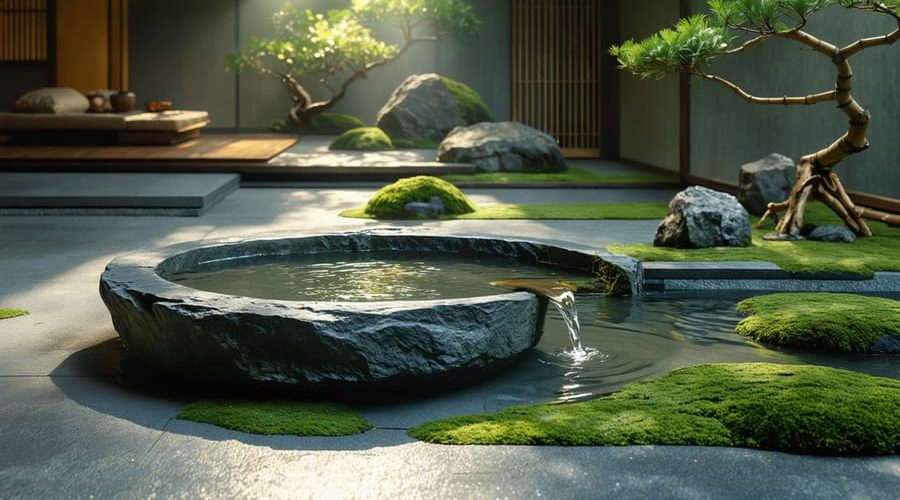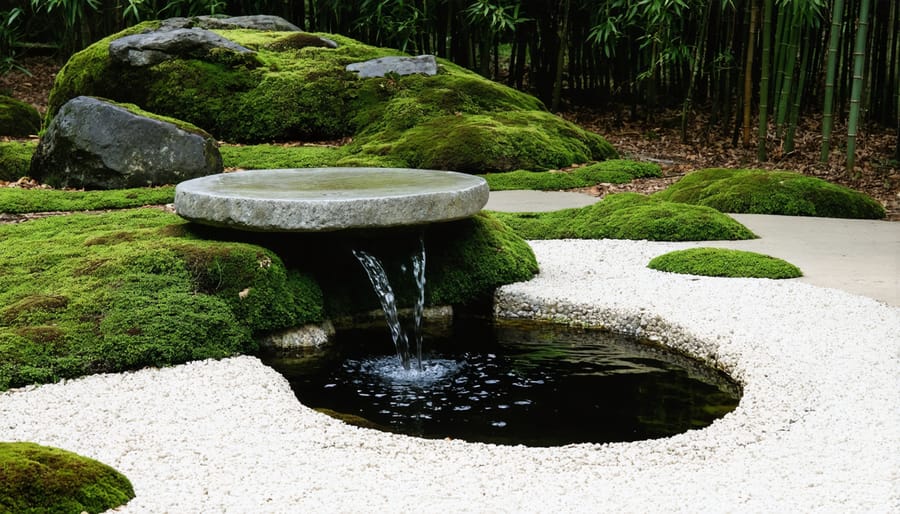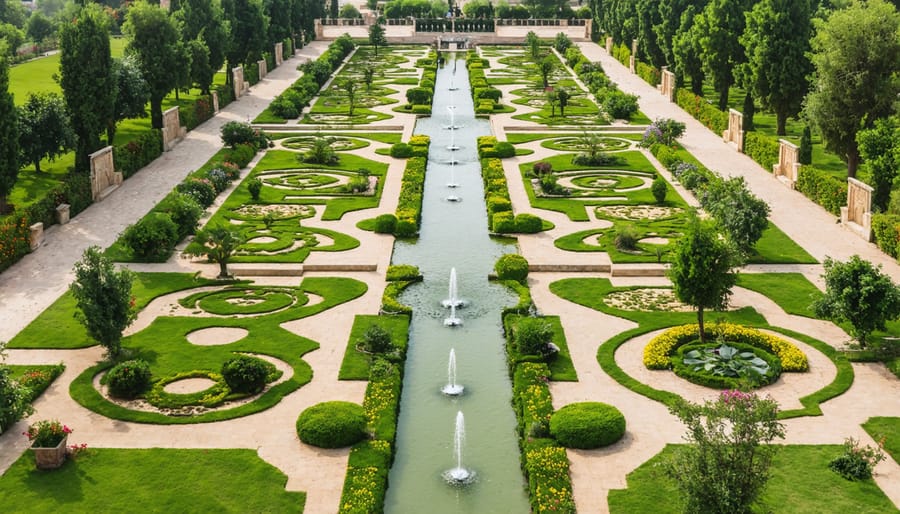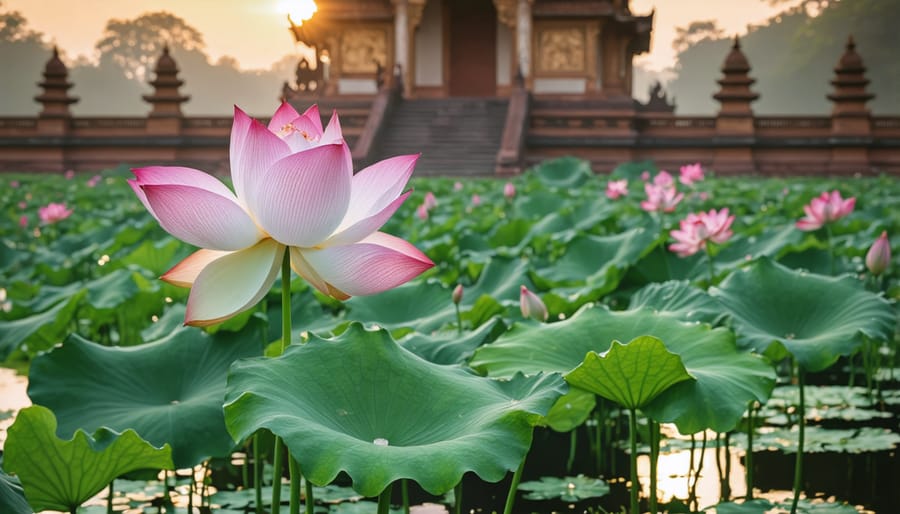
Sacred Waters: How Ancient Water Garden Rituals Still Inspire Modern Design
Transform your garden into a sacred sanctuary by incorporating ancient ritualistic practices that have shaped water features for millennia. From the meditative pools of Japanese Zen gardens to the symbolic water features of classical Greece, ritualistic elements in garden design speak to something deeper in the human experience.
Water has long served as a bridge between the physical and spiritual realms, with cultures worldwide developing sophisticated practices around its use in sacred spaces. These traditions offer modern gardeners a rich template for creating meaningful outdoor environments that nourish both body and soul.
Whether you’re designing a small meditation pond or an elaborate water garden, incorporating ritualistic elements can transform an ordinary space into one that inspires contemplation and connection. Traditional practices teach us that the placement of rocks, the flow of water, and even the types of plants we choose can create powerful symbolic meanings that resonate across centuries.
Today’s garden enthusiasts can easily adapt these ancient principles to create spaces that honor both historical traditions and contemporary needs. By understanding the spiritual significance behind different design elements, you can craft a water garden that serves not just as a beautiful feature, but as a personal sanctuary for reflection and renewal.
Japanese Water Garden Rituals
Tea Ceremony Gardens
The Japanese tea ceremony, or chanoyu, represents one of the most refined examples of how historical water garden designs blend with spiritual practices. At the heart of these gardens, you’ll find the tsukubai, a stone water basin that serves both practical and symbolic purposes. This essential feature allows guests to purify themselves by washing their hands and rinsing their mouths before entering the tea house.
Traditional tea gardens incorporate water features that create a sense of tranquility through their gentle sounds and movement. The most common elements include bamboo fountains (shishi-odoshi) and stone water basins (chozubachi), each carefully positioned to enhance the meditation-like experience of the tea ceremony.
What makes these gardens unique is their thoughtful design principle of “less is more.” Unlike elaborate fountain displays, tea ceremony water features are intentionally subtle and understated. The sound of water dropping from a bamboo spout into a stone basin creates a rhythmic atmosphere that helps guests transition from the busy outside world to the peaceful ceremonial space.
For modern garden enthusiasts looking to incorporate these elements, simplicity is key. A small stone basin with a bamboo spout can transform any corner of your garden into a contemplative space. Remember, the goal isn’t to overwhelm the senses but to create moments of quiet reflection and spiritual connection through the gentle presence of water.

Zen Garden Elements
Zen gardens, or karesansui, embrace a profound connection between daily maintenance and spiritual practice. The ritualistic raking of gravel represents more than just keeping the garden tidy – it’s a meditative practice that helps cultivate mindfulness and inner peace. Each morning, monks traditionally rake precise patterns into the gravel, creating rippling water effects that encourage contemplation.
The maintenance itself follows specific patterns and movements. Raking is performed in straight lines or concentric circles around rock formations, with practitioners maintaining a steady, rhythmic motion. This isn’t just about achieving visual perfection; it’s about finding harmony between the gardener and the garden elements.
Water features in Zen gardens, whether actual pools or symbolic representations, play a crucial role in these rituals. The sound of flowing water or the visual suggestion of water through carefully raked gravel patterns helps create a tranquil atmosphere conducive to meditation. Regular pruning of plants, especially moss and small shrubs, is performed with careful attention to maintain the garden’s intended form while respecting natural growth patterns.
Modern gardeners can incorporate these practices into their own spaces by setting aside regular times for mindful garden maintenance. Even simple tasks like clearing leaves or adjusting stones can become meaningful rituals when approached with intention and awareness. The key is to view garden maintenance not as a chore, but as an opportunity for peaceful reflection and connection with nature.
Islamic Paradise Gardens
Four-Part Design Symbolism
The chahar bagh design, meaning “four gardens” in Persian, represents one of the most influential examples of sacred water symbolism in garden design. This four-part layout divides the garden into equal squares, with water features playing a central role in connecting these spaces. Traditionally, four water channels meet at the center, creating a cross pattern that symbolizes the four rivers of Paradise described in ancient texts.
Each section of the chahar bagh carries deep spiritual meaning. The north quarter represents winter and reflection, the east signifies spring and new beginnings, the south embodies summer and growth, while the west symbolizes autumn and wisdom. Water flows through these sections, unifying the design and creating a sense of harmony that gardeners still appreciate today.
You can incorporate this meaningful design into your own garden by dividing your space into four distinct areas connected by narrow water channels or simple pathways. Even in smaller spaces, you might create a scaled-down version using a central fountain surrounded by four planted beds. The key is maintaining balance and symmetry while letting water serve as the connecting element.
This timeless design reminds us that our gardens can be more than just beautiful spaces – they can be sanctuaries that connect us to ancient wisdom and bring spiritual meaning to our outdoor environments.

Water as Purification
Water plays a central role in Islamic purification rituals, and traditional Islamic gardens often incorporate specific water features designed for ritual cleansing, known as wudu. This ceremonial washing is performed before daily prayers and involves cleaning the hands, face, arms, and feet in a precise sequence.
In Islamic garden design, you’ll typically find dedicated ablution fountains or pools near prayer spaces. These water features are both practical and beautiful, often featuring geometric patterns and calming water flows that create a serene atmosphere for spiritual preparation.
Modern Islamic-inspired gardens continue this tradition by including designated washing areas that blend seamlessly with contemporary design elements. For home gardeners interested in incorporating these principles, consider creating a peaceful corner with a small fountain or basin surrounded by aromatic herbs like mint and jasmine, which are traditionally associated with Islamic gardens.
The water used for purification must be clean and flowing, representing both physical and spiritual purity. Many garden designers achieve this by installing recirculating fountain systems that maintain water clarity while creating gentle sounds that enhance the meditative atmosphere.
When planning such spaces, it’s important to consider accessibility and privacy. Traditional designs often include screening elements like decorative screens or strategic plantings that provide seclusion while maintaining the garden’s aesthetic appeal.
Hindu Water Gardens
Sacred Lotus Pools
The Sacred Lotus (Nelumbo nucifera) holds deep spiritual significance in many Eastern religions, particularly in Buddhism and Hinduism. These magnificent flowers emerge pristine from muddy waters, symbolizing spiritual enlightenment and divine purity. Traditional lotus pools are carefully designed spaces that serve both practical and spiritual purposes, often found within temple grounds or meditation gardens.
In Buddhist tradition, lotus pools represent the journey from darkness to enlightenment. The depth of these pools typically ranges from 18 to 24 inches, providing ideal growing conditions for lotus plants while maintaining their symbolic connection to spiritual practice. Practitioners often incorporate these pools into their daily meditation routines, using the lotus as a focal point for contemplation.
Modern gardeners can create their own sacred lotus pools by following ancient design principles. Start with a sunny location and ensure proper water depth. The pool’s edges should be gently sloped, allowing for different planting zones. Traditional designs often include stone lanterns, stepping stones, and seating areas for meditation.
To maintain the spiritual atmosphere, consider adding elements like prayer flags, bells, or Buddhist statuary. The key is creating a tranquil space that encourages reflection. Regular maintenance includes removing dead leaves and flowers, which helps preserve the pool’s symbolic purity while ensuring healthy plant growth.
Remember, a sacred lotus pool is more than just a water feature – it’s a living symbol of spiritual growth and inner peace.

Festival Celebrations
Water plays a central role in Hindu festival celebrations, with garden ponds and water features serving as focal points for many sacred ceremonies. During Chhath Puja, devotees gather around water bodies at sunrise and sunset to honor the Sun God, often decorating the surrounding garden space with marigolds and floating oil lamps.
The vibrant festival of Holi takes on special significance in garden settings, where participants playfully sprinkle colored water on each other near decorative fountains and pools. These water features are carefully prepared beforehand, cleaned and adorned with fresh flowers and leaves to create an inviting atmosphere for the celebrations.
Ganesh Chaturthi involves the ritual immersion of Lord Ganesha idols in water bodies, with many families creating dedicated immersion spots in their garden ponds. The surrounding area is typically decorated with rangoli patterns and traditional plants like tulsi and banana trees.
During Navaratri, garden ponds become gathering spots for evening aarti ceremonies, where floating diyas illuminate the water while devotees sing hymns. Many families maintain small shrine areas near their water features specifically for these occasions, incorporating elements like stone benches and pathways for comfortable worship.
Year-round, these garden water features serve as spaces for daily rituals like offering flowers and lighting incense, combining practical garden design with spiritual significance. The careful integration of these elements creates a harmonious environment that honors both tradition and natural beauty.
Modern Adaptations
In today’s fast-paced world, incorporating traditional water garden elements into modern spaces doesn’t mean sacrificing convenience or style. The key lies in finding creative ways to blend ancient wisdom with contemporary design principles.
Start by considering the placement of water features according to feng shui principles. Even in a small urban garden, positioning your pond or fountain in the north or east area can create harmony while maintaining a modern aesthetic. Use clean lines and simple geometrical shapes that echo traditional designs but feel current and fresh.
Traditional Japanese elements can be adapted using modern materials. Instead of traditional wooden bridges, consider sleek steel or glass alternatives that maintain the same symbolic connection between different garden areas. Replace traditional stone lanterns with subtle LED lighting that creates similar ambiance without appearing dated.
Sacred lotus and water lilies remain timeless choices, but consider combining them with modern water-loving plants that require less maintenance. Float glass orbs or contemporary sculptures alongside these classic elements to create an intriguing dialogue between old and new.
For those drawn to Native American water traditions, incorporate circular design elements using current hardscaping materials. Modern concrete or composite decking can create the same meditative pathways traditionally made with natural stone, while being more durable and easier to maintain.
Sound remains a crucial element in ritualistic water gardens. Instead of traditional bamboo deer scarers, consider installing adjustable contemporary water features that create similar peaceful sounds. Smart technology can even allow you to control water flow patterns and lighting to enhance meditation sessions.
Create designated reflection areas using comfortable modern seating rather than traditional stone benches. Weather-resistant materials like powder-coated aluminum can mimic the appearance of ancient metal work while offering superior durability.
Remember that ritual spaces don’t need to be elaborate. A simple container water garden on an urban balcony can incorporate meaningful elements like cardinal directions and sacred geometry through thoughtful placement and modern vessel choices. The goal is to honor traditional principles while creating spaces that feel relevant and accessible in contemporary life.
As we reflect on the rich tapestry of ritualistic practices in water gardens across cultures, it becomes clear that these traditions hold immense value for modern garden enthusiasts. While our contemporary lives may seem far removed from ancient ceremonies, the fundamental human connection to water and its spiritual significance remains unchanged.
Today’s water gardeners can honor these time-honored practices while adapting them to fit modern sensibilities. Consider incorporating meditation spaces near your pond, adding traditional elements like stone lanterns or Buddha statues, or creating your own meaningful rituals around maintaining your water garden. These personal touches can transform routine maintenance into mindful moments of connection with nature.
The preservation of cultural water garden practices isn’t just about maintaining tradition – it’s about enriching our modern lives with wisdom passed down through generations. Whether you’re drawn to Japanese zen principles, Chinese feng shui, or Native American water blessing ceremonies, there’s room to respectfully incorporate these elements into your garden design.
Remember that adaptation doesn’t mean losing authenticity. Simple acts like morning reflection by the water’s edge or mindful feeding of koi can become your own meaningful rituals. By finding this balance between honoring traditional practices and creating new ones, we ensure that the spiritual significance of water gardens continues to evolve and inspire future generations of gardeners.
